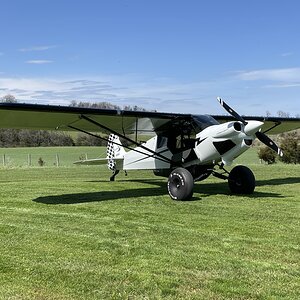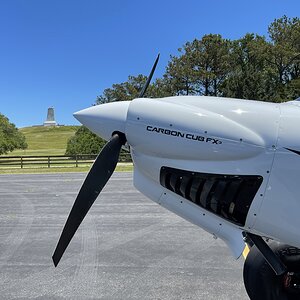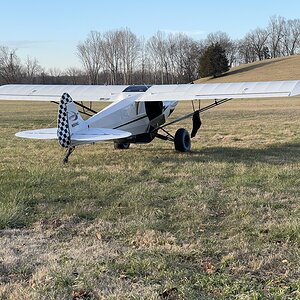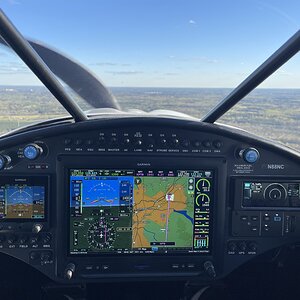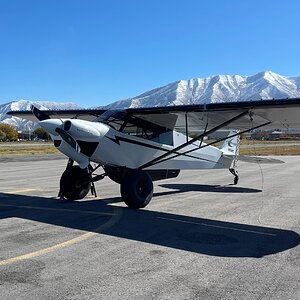avbug;1127356 Perhaps you didn't notice that I described experience with these systems. But I am curious what would prompt you to make such an ignorant statement.[/quote said:Yes, I noticed experience, but perhaps, not expertise with specific units.
I've read most of your postings/replies for several years, and your written thoughts are usually a 180 from those who actually invest in these systems and go to the trouble to use them efficiently and correctly.
And you go to a lot of trouble explaining why the technology that I describe seems to cause more harm than good; yet I know so many others who are involved in research and development, as well as many owners who feel completely different from you. And as I said, many of these owners are retired commercial and military pilots who appear to have very positive thoughts on this subject; and are willing to spend the money for this advanced technology.
And my apologies for making an ignorant statement. I know you certainly never would.
Navigation
Install the app
How to install the app on iOS
Follow along with the video below to see how to install our site as a web app on your home screen.
Note: This feature may not be available in some browsers.
More options
Welcome to Flightinfo.com
- Register now and join the discussion
- Friendliest aviation Ccmmunity on the web
- Modern site for PC's, Phones, Tablets - no 3rd party apps required
- Ask questions, help others, promote aviation
- Share the passion for aviation
- Invite everyone to Flightinfo.com and let's have fun
You are using an out of date browser. It may not display this or other websites correctly.
You should upgrade or use an alternative browser.
You should upgrade or use an alternative browser.
We sure can learn from this accident
- Thread starter Erlanger
- Start date
- Watchers 9
You are mistaken that once a pilot talks to ATC and receives a "remain VFR" statement, that the pilot is "under ATC control." ATC provided a Class B VFR clearance, and advised the pilot to expect an IFR clearance once he reached 5,000'. The crew assumed their own terrain separation by electing to depart VFR and to not make contact until airborne.
I am certainly not trying to start a flame war here, I am just trying to learn. But below is from page 18 of the report.
This to me implies that ATC did indeed have responsibility to make sure that the plane didn't hit the mountain. I think the rule sucks, but it is there to be followed.Although the flight crew is responsible for maintaining terrain clerance while operating under VFR, FAA Order 7110.65P, chapter 4-2-8 states that, when an aircraft is operating under VFR below minimum IFR altitude and the flight crew requests an IFR clearance, the controller should ask the crewmembers if they would be able to maintain terrain and obstruction clearance during the climb to minimum IFR altitude. The order also states that, if the controller provides an instruction (such as turn to a heading of 020), the responsibility for terrain clearance is transferred to the FAA. The order advises controllers not to "assign (or imply) specific course guidance that will (or could) be in effect below the MIA or MEA." During a postaccident interview, the controller stated that he was unaware of this responsibility.
Believe me, I am no FAA apologist. But I think it is unfair to JUST blame the pilot and not see that mistakes were made on both sides. It always takes a series of events to happen in just the right (wrong) way to cause an accident. And again, as I said before, the pilot was the most responsible because it was his soul (and those trusting theirs to him) in that plane. I get that. However, this controller should not be able to walk away scott free from this incident either IMHO.
satpak77
Marriott Platinum Member
- Joined
- Dec 2, 2003
- Posts
- 3,015
I am certainly not trying to start a flame war here, I am just trying to learn. But below is from page 18 of the report.
This to me implies that ATC did indeed have responsibility to make sure that the plane didn't hit the mountain. I think the rule sucks, but it is there to be followed.
Believe me, I am no FAA apologist. But I think it is unfair to JUST blame the pilot and not see that mistakes were made on both sides. It always takes a series of events to happen in just the right (wrong) way to cause an accident. And again, as I said before, the pilot was the most responsible because it was his soul (and those trusting theirs to him) in that plane. I get that. However, this controller should not be able to walk away scott free from this incident either IMHO.
That order applies to ATC personnel. It is not codified into the FAR/AIM. As such, ultimate responsiblity is the pilot's, not the controllers.
Lets take a look at the actual order, now version "R"
http://www.faa.gov/ATPubs/ATC/
http://www.faa.gov/ATPubs/ATC/Chp1/atc0101.html#1-1-1
1-1-1. PURPOSE This order prescribes air traffic control procedures and phraseology for use by persons providing air traffic control services. Controllers are required to be familiar with the provisions of this order that pertain to their operational responsibilities and to exercise their best judgment if they encounter situations that are not covered by it.
Had the FAA intended for pilots to be familiar with the above document, the would incorporate it into the PTS standards (they would have to).
However, it is not. The following documents ARE, however, see page 9 of the actual pdf file, or page 3 of the document itself.
http://www.faa.gov/education_research/testing/airmen/test_standards/pilot/media/FAA-S-8081-14A.pdf
also, page 12 of 73 of the pdf file below
http://www.faa.gov/education_research/testing/airmen/test_standards/pilot/media/FAA-S-8081-5D.pdf
So basically, the FAA is saying "these manuals and books are what you need to be familiar with to qualify and for this rating and subsequently safely fly using this rating" (private pilot ops, ATP ops, etc)
The FAA order is not in there
Last edited:
I've read most of your postings/replies for several years, and your written thoughts are usually a 180 from those who actually invest in these systems and go to the trouble to use them efficiently and correctly.
You're right...I don't own the equipment. Most professional pilots don't. My experience with these systems is limited to using them on a daily basis for many years as a professional ATP pilot.
Publishers
Well-known member
- Joined
- Sep 20, 2002
- Posts
- 1,736
If indeed basic airmanship principles are considered "old school," and "180 out" as mtrv would submit, indeed it's a sad day for us all. Regardless of what aids we have in the cockpit, we are never more than a step removed from the basics. Failure to retain and use them, failure to follow basic principles of safety, failure to engage in risk-elimination as a constant state of vigilence, produces exactly what we see in the case under discussion.
Unfortunately, those who learn this lesson can't pass it on from their grave, only teach by the example of their death.
All the gadgetry in the world cannot save a pilot from himself.
Unfortunately, those who learn this lesson can't pass it on from their grave, only teach by the example of their death.
All the gadgetry in the world cannot save a pilot from himself.
satpak77
Marriott Platinum Member
- Joined
- Dec 2, 2003
- Posts
- 3,015
All the gadgetry in the world cannot save a pilot from himself.
best quote on this thread!
All the gadgetry in the world cannot save a pilot from himself.
Possibly not, but the technology can sure change the odds.
Jeeze, should I happen to be a lowly passenger, I'd certainly want better odds! Look up the review boards recommendations from the Ron Brown 737 flight into terrain, as well as the AA757 flight into terrain accident. And while your at it, same for the military's C-130 out of Jackson Hole.
If you want to continue using the word gagetry, then fine. The term toys or non-essentials will do too! I know where your coming from, and it's just what I expected.
You're right...I don't own the equipment. Most professional pilots don't. My experience with these systems is limited to using them on a daily basis for many years as a professional ATP pilot.
A --- these systems have not existed for many years
B--- the majority of commercial aircraft don't have them
C--- a few professional pilots who have had the opportunity to use the systems I refer to, sure wish they had them
D--- If you get the chance to fly Boeings new Dreamliner, then you'll finally have it, without owning it.
I know where your coming from, and it's just what I expected.
My wife say's I'm a jerk for writing this way. Perhaps so.
I'll let it rest.
WabiSabi
Well-known member
- Joined
- May 30, 2006
- Posts
- 437
My experience with these systems is limited to using them on a daily basis for many years as a professional ATP pilot.
....like my many years of going to an "ATM machine"
EGPWS, TAWS, TCAS, moving maps, GPS, FMS...these are not exactly new technology reserved for a fractional percentage of the professional pilots out there...most of us use them on a constant basis. Nothing new there.
Interesting you picked the Jackson Hole C-130 loss...as it's not gadgetry that would have saved them, but adherence to any one of a dozen basic proceedures...starting with the cockpit crew using the same charts. Or following proceedures. A classic human failure. The crew didn't avail themselves of what they did have available...no reason to expect that they'd have had more success with more available to them. Bottom line is that they screwed up from the word go. They didn't even ensure they were using the same charts for reference.
I think I make an accurate prediction when I say I'll never fly the "dreamliner." I don't have any desire to, either.
I don't believe in odds. If youre playing the chance game and playing odds, you need to get out of avaition before you kill someone. This isn't a guessing game. It's a profession. A professional will have a basic skill level notwithstanding toys, non-essentials, or gadgetry in the cockpit. I have never stated that this equipment should not be used, but the pilot who fails basic airmanship cannot be saved by this equipment. Such lapses and human failures will eventually win, as we see time and time again.
If you find this equipment necessary, then your basic skills have already eroded, and you fit this category. Ignore this failure at your own peril.
Interesting you picked the Jackson Hole C-130 loss...as it's not gadgetry that would have saved them, but adherence to any one of a dozen basic proceedures...starting with the cockpit crew using the same charts. Or following proceedures. A classic human failure. The crew didn't avail themselves of what they did have available...no reason to expect that they'd have had more success with more available to them. Bottom line is that they screwed up from the word go. They didn't even ensure they were using the same charts for reference.
I think I make an accurate prediction when I say I'll never fly the "dreamliner." I don't have any desire to, either.
I don't believe in odds. If youre playing the chance game and playing odds, you need to get out of avaition before you kill someone. This isn't a guessing game. It's a profession. A professional will have a basic skill level notwithstanding toys, non-essentials, or gadgetry in the cockpit. I have never stated that this equipment should not be used, but the pilot who fails basic airmanship cannot be saved by this equipment. Such lapses and human failures will eventually win, as we see time and time again.
If you find this equipment necessary, then your basic skills have already eroded, and you fit this category. Ignore this failure at your own peril.
I don't believe in odds. If youre playing the chance game and playing odds, you need to get out of avaition before you kill someone.
The chance of mechanical failure will always have a percentage of odds. And with human failure it's always a chance of odds.
The statistics prove this fact over and over, and can't be denied. To claim that you don't believe in odds, and won't use technology to put odds in your, or your passengers favor is nonsense.
A synthetic 3D topography display in IMC conditions is like the ability to look down the barrel of that pistol, and actually see that one bullet in place. If you still want to pull the trigger, then it's up to you. But the odds have drastically changed.
But of course, I would never play Russian Roulette. I'd always know that I could see the bullet ahead of time. That's just my mentality.
And then I read the next reply. "They hit a mountain, end of story". Well that's nonsense too! This whole disccusion is getting much to lame for my taste.
satpak77
Marriott Platinum Member
- Joined
- Dec 2, 2003
- Posts
- 3,015
This whole disccusion is getting much to lame for my taste.
good, maybe that post will be your last one on this thread.
of course, if you just can't stay away...
Latest resources
-
-
-
-
-
AC 90-89C - Amateur-Built Aircraft and Ultralight Flight Testing HandbookAmateur-Built Aircraft and Ultralight Flight Testing Handbook
- Neal
- Updated:

